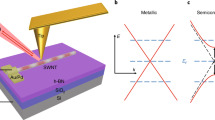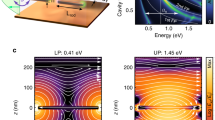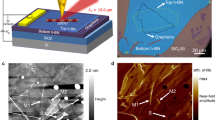Abstract
Surface plasmons1, collective oscillations of conduction electrons, hold great promise for the nanoscale integration of photonics and electronics1,2,3,4. However, nanophotonic circuits based on plasmons have been significantly hampered by the difficulty in achieving broadband plasmonic waveguides that simultaneously exhibit strong spatial confinement, a high quality factor and low dispersion. Quantum plasmons, where the quantum mechanical effects of electrons play a dominant role, such as plasmons in very small metal nanoparticles5,6 and plasmons affected by tunnelling effects7, can lead to novel plasmonic phenomena in nanostructures. Here, we show that a Luttinger liquid8,9 of one-dimensional Dirac electrons in carbon nanotubes10,11,12,13 exhibits quantum plasmons that behave qualitatively differently from classical plasmon excitations. The Luttinger-liquid plasmons propagate at ‘quantized’ velocities that are independent of carrier concentration or excitation wavelength, and simultaneously exhibit extraordinary spatial confinement and high quality factor. Such Luttinger-liquid plasmons could enable novel low-loss plasmonic circuits for the subwavelength manipulation of light.
This is a preview of subscription content, access via your institution
Access options
Subscribe to this journal
Receive 12 print issues and online access
$209.00 per year
only $17.42 per issue
Buy this article
- Purchase on Springer Link
- Instant access to full article PDF
Prices may be subject to local taxes which are calculated during checkout




Similar content being viewed by others
References
Barnes, W. L., Dereux, A. & Ebbesen, T. W. Surface plasmon subwavelength optics. Nature 424, 824–830 (2003).
Gramotnev, D. K. & Bozhevolnyi, S. I. Plasmonics beyond the diffraction limit. Nature Photon. 4, 83–91 (2010).
Schuller, J. A. et al. Plasmonics for extreme light concentration and manipulation. Nature Mater. 9, 193–204 (2010).
Pendry, J. B., Aubry, A., Smith, D. R. & Maier, S. A. Transformation optics and subwavelength control of light. Science 337, 549–552 (2012).
Halperin, W. P. Quantum size effects in metal particles. Rev. Mod. Phys. 58, 533–606 (1986).
Scholl, J. A., Koh, A. L. & Dionne, J. A. Quantum plasmon resonances of individual metallic nanoparticles. Nature 483, 421–427 (2012).
Tan, S. F. et al. Quantum plasmon resonances controlled by molecular tunnel junctions. Science 343, 1496–1499 (2014).
Luttinger, J. M. An exactly soluble model of a many-fermion system. J. Math. Phys. 4, 1154–1162 (1963).
Voit, J. One-dimensional Fermi liquids. Rep. Prog. Phys. 58, 977–1116 (1995).
Kane, C., Balents, L. & Fisher, M. P. A. Coulomb interactions and mesoscopic effects in carbon nanotubes. Phys. Rev. Lett. 79, 5086–5089 (1997).
Egger, R. & Gogolin, A. O. Effective low-energy theory for correlated carbon nanotubes. Phys. Rev. Lett. 79, 5082–5085 (1997).
Bockrath, M. et al. Luttinger-liquid behaviour in carbon nanotubes. Nature 397, 598–601 (1999).
Yao, Z., Postma, H. W. C., Balents, L. & Dekker, C. Carbon nanotube intramolecular junctions. Nature 402, 273–276 (1999).
Liu, K. et al. An atlas of carbon nanotube optical transitions. Nature Nanotech. 7, 325–329 (2012).
Ando, T., Nakanishi, T. & Saito, R. Berry's phase and absence of back scattering in carbon nanotubes. J. Phys. Soc. Jpn 67, 2857–2862 (1998).
McEuen, P. L., Bockrath, M., Cobden, D. H., Yoon, Y. G. & Louie, S. G. Disorder, pseudospins, and backscattering in carbon nanotubes. Phys. Rev. Lett. 83, 5098–5101 (1999).
Javey, A., Guo, J., Wang, Q., Lundstrom, M. & Dai, H. J. Ballistic carbon nanotube field-effect transistors. Nature 424, 654–657 (2003).
Park, J. Y. et al. Electron–phonon scattering in metallic single-walled carbon nanotubes. Nano Lett. 4, 517–520 (2004).
Purewal, M. S. et al. Scaling of resistance and electron mean free path of single-walled carbon nanotubes. Phys. Rev. Lett. 98, 186808 (2007).
Ishii, H. et al. Direct observation of Tomonaga–Luttinger-liquid state in carbon nanotubes at low temperatures. Nature 426, 540–544 (2003).
Hillenbrand, R., Knoll, B. & Keilmann, F. Pure optical contrast in scattering-type scanning near-field microscopy. J. Microsc. 202, 77–83 (2001).
Bechtel, H. A., Muller, E. A., Olmon, R. L., Martin, M. C. & Raschke, M. B. Ultrabroadband infrared nanospectroscopic imaging. Proc. Natl Acad. Sci. USA 111, 7191–7196 (2014).
Gerber, J. A., Berweger, S., O'Callahan, B. T. & Raschke, M. B. Phase-resolved surface plasmon interferometry of graphene. Phys. Rev. Lett. 113, 055502 (2014).
Boltasseva, A. & Atwater, H. A. Low-loss plasmonic metamaterials. Science 331, 290–291 (2011).
Arnold, M. S., Green, A. A., Hulvat, J. F., Stupp, S. I. & Hersam, M. C. Sorting carbon nanotubes by electronic structure using density differentiation. Nature Nanotech. 1, 60–65 (2006).
Fei, Z. et al. Gate-tuning of graphene plasmons revealed by infrared nano-imaging. Nature 487, 82–85 (2012).
Chen, J. et al. Optical nano-imaging of gate-tunable graphene plasmons. Nature 487, 77–81 (2012).
Liu, K. H. et al. High-throughput optical imaging and spectroscopy of individual carbon nanotubes in devices. Nature Nanotech. 8, 917–922 (2013).
Palik, E. D. Handbook of Optical Constants of Solids (Elsevier, 1997).
Suzuura, H. & Ando, T. Phonons and electron–phonon scattering in carbon nanotubes. Phys. Rev. B 65, 235412 (2002).
Acknowledgements
The authors thank M. Raschke for discussions. H.B. and M.M., in particular, thank M. Raschke and his group for the years of pioneering research on infrared near-field techniques and key collaborations that led to the development of a near-field infrared instrument at the Advanced Light Source (ALS). The authors also thank K. Liu, Y. Sun, S. Shi, C. Jin and H. Chang for their help with sample preparation and discussions. This work was primarily supported by the Office of Basic Energy Science, Department of Energy (contract no. DE-AC02-05CH11231, Sub-Wavelength Metamaterial Program; contract no. DE-SC0003949, Early Career Award). Spectroscopy of nanotubes in the visible range was supported by the National Science Foundation (grant no. DMR-1404865). The ALS is supported by the Director, Office of Science, Office of Basic Energy Sciences, of the US Department of Energy (contract no. DE-AC02-05CH11231). F.W. acknowledges support from a David and Lucile Packard fellowship.
Author information
Authors and Affiliations
Contributions
F.W. and Z.S. conceived the project. Z.S. and X.H. prepared the nanotube samples. Z.S., H.B. and M.C.M. performed the near-field infrared measurements. X.H. and Z.B. performed visible spectroscopy. K.W. and T.T. provided the hBN crystals. X.H., Z.S., Y.R.S. and F.W. analysed the data. All authors discussed the results and contributed to writing the manuscript.
Corresponding authors
Ethics declarations
Competing interests
The authors declare no competing financial interests.
Supplementary information
Supplementary information
Supplementary information (PDF 476 kb)
Rights and permissions
About this article
Cite this article
Shi, Z., Hong, X., Bechtel, H. et al. Observation of a Luttinger-liquid plasmon in metallic single-walled carbon nanotubes. Nature Photon 9, 515–519 (2015). https://doi.org/10.1038/nphoton.2015.123
Received:
Accepted:
Published:
Issue Date:
DOI: https://doi.org/10.1038/nphoton.2015.123
This article is cited by
-
Manipulating hyperbolic transient plasmons in a layered semiconductor
Nature Communications (2024)
-
Planar hyperbolic polaritons in 2D van der Waals materials
Nature Communications (2024)
-
Tunable growth of one-dimensional graphitic materials: graphene nanoribbons, carbon nanotubes, and nanoribbon/nanotube junctions
Scientific Reports (2023)
-
Imaging gate-tunable Tomonaga–Luttinger liquids in 1H-MoSe2 mirror twin boundaries
Nature Materials (2022)
-
Electronic thermal transport measurement in low-dimensional materials with graphene non-local noise thermometry
Nature Nanotechnology (2022)



